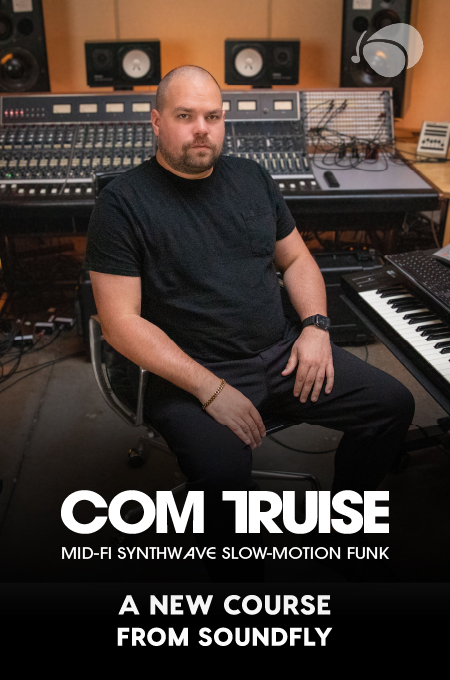+ Take your modern jazz piano and hip-hop beat making to new heights with Soundfly’s new course, Elijah Fox: Impressionist Piano & Production!
I took piano lessons for many of my childhood years. And though there was never any question that violin was my main instrument, there were quite a few things about the piano that I really liked.
I mean, not having to worry about intonation was freaking awesome. And being able to play more than 2 or 3 notes at a time? And really loudly at that? That was also pretty cool.
But as satisfying as it was to play a single note or chord, and have it sound pretty darn good despite my very mediocre piano skills, the challenge, of course, was stringing multiple good-sounding notes together. Because, I mean, sooooo many notes! Two hands! Doing completely different things! Ack!
Of course, on some level, I suppose it’s all kind of the same, whether we’re talking about piano, violin, clarinet, percussion, or voice. Because no matter the instrument, making music is not about making one note sound good — it’s about connecting notes in a meaningful and compelling way.
Taking single, discrete, motor actions (a single note), and linking them together into a longer and more complex sequence of movements (a phrase). Which is a process known as “binding” in the neuroscience literature. And apparently, how the brain does this has been a bit of a mystery — though a recent study provides some pretty intriguing clues.
So how does the brain actually string together single actions into sequences? And why should we care? Like, does this have any practical implications for how we should structure our daily practice?
A Simple Motor Sequence
A team of researchers (Buch et al., 2021) recruited 33 right-handed individuals to participate in a simple learning study.
Each of the participants was asked to sit in front of a computer screen and type out a particular sequence of numbers (41324, for what it’s worth) on a number pad with their left hand, as quickly and accurately as possible.
They were given 36 10-second blocks of time to practice this number sequence, with a 10-second break between each practice block.
In other words, when the practice block began, the numbers 41324 would appear on the screen, and they’d practice typing out 41324 as quickly and accurately as possible until 10 seconds had passed, at which point the numbers on the screen would be replaced with x’s, and they’d sit there and look at the x’s, until the numbers reappeared and the next 10-second practice block began.
While engaged in this practice activity, the participants were all hooked up to an MEG (magnetoencephalography) device, which is a type of brain imaging technology that detects and records neuromagnetic activity within the brain on a millisecond-to-millisecond basis, allowing researchers to map this activity to specific parts of the brain.
Here’s a short video on how MEG works, if you’re looking for a way to procrastinate on practicing (😅).
And what were researchers looking for?
+ Read more on Flypaper: “How Do Fear, Anxiety, and Other Negative Emotions Affect the Learning Process?”
“Neural Replay?”
Well, one of the theories that has been proposed to explain this binding process, is that of “neural replay;” where during pauses in our practice, the brain basically reactivates the same neural circuits that are activated when physically performing the skill — only much faster. Kind of as if our brain were fast forwarding through the sequence of motor movements a bunch of times to reinforce what it just did.
So the researchers were curious to see if they would find evidence of this sort of neural activity during the 10-second practice breaks.
And did they?
Learning Occurred When?!
Well, they found a couple things.
First off, typing out 41324 is not a super difficult task. And most participants got the hang of the task pretty quickly, with about 95% of their learning gains taking place within the first 11 or so practice blocks.
And when researchers took a closer look at the rate of improvement during this early learning period, they found that most of the gains in performance occurred not during the practice blocks when participants were actively typing out the numbers, but between the practice blocks, when they were resting.
I know. That’s a little surprising, right? Because this suggests that the break or periods of “waking rest” between practice blocks were as integral a part of learning as the practice itself.
But as one of the NIH researchers involved in the study noted:
“It seems to be that most, if not all, of early learning occurs over these rest periods and virtually nothing is detected during the practice intervals.”
And why might that be?
Neural Replay Seems to Be a Thing
Well, this goes back to that theory about neural replay.
And when the researchers looked for evidence of this in the MEG data, they found that indeed, during the 10-second rest breaks between practice blocks, the brain appeared to reactivate or “replay” the same neural circuits associated with performing the task physically — just 20 times faster.
A speed which suggests that this was all happening in the background, and isn’t related to imagery or mental practice, which generally isn’t time-compressed in this way, and takes about the same amount of time as performing the skill itself.
So what are we to do with all of this?
Takeaways
Well, when it comes to the consolidation of motor skills (i.e. getting skills into “muscle memory”), previous research has established that getting good sleep is an important factor in this process. (*Here’s a great video of violist Molly Gebrian summarizing some of the research on sleep’s role in learning.)
But today’s study suggests that integrating “waking rest” into our practice could be a really important factor to consider as well.
There isn’t enough research out there yet to know exactly what the optimal formula for rest and practice might be for maximimal learning, so it doesn’t mean that we must always integrate a 10-second pause into our practice after every 10 seconds of practice. Because that would probably be pretty annoying.
But I do think it’d be worth experimenting with tiny micro-breaks throughout a practice session, between groups of practice repetitions. Like, instead of hammering away at a difficult passage over and over and over until you’re satisfied with it, maybe…
- Allow yourself just a few repetitions or a few minutes worth of repetitions to see if you can get the problem passage to sound just right.
- And then, whether you’ve solved the problem or not, take a nice, deep, meditative, one-breath micro-break (no sneaking a glance at your phone notifications!).
- And then test out the passage again to see if the improvements stuck, or try it a few more times to see if you can get closer to the solution.
- And then take another micro-break, and so on, until you’ve reached the end of your allotted practice time or finished your to-do list for that session.
You’ll undoubtedly have to experiment with the spacing and duration of these micro-breaks in your practice so that it feels helpful, and not a frustrating interruption to your practice flow. And there’s a big difference between these within-session micro-breaks, and those longer practice breaks that you take between practice sessions, where you get sucked into a YouTube rabbit hole, only to emerge hours later, no longer in the right headspace to get anything productive done…
But whatever sort of micro-break schedule you end up settling on, what I like about this particular practice hack, is that regardless of the potential learning benefits, the idea of a micro-break is probably a good one to explore anyway, from a purely physical perspective. Because micro-breaks are a nice way to release muscle tension and avoid that tendency to get progressively more tense and wound up as our practice session progresses.
So at first glance, reducing the number of repetitions you engage in during practice might seem like a counterproductive learning strategy, but if integrating a few short pauses into your practice sessions every few minutes could accelerate learning and also help to prevent pain and injury, it certainly seems like a hack worth trying.
Play Your Heart Out!
Continue your learning adventure on Soundfly with modern, creative courses on songwriting, mixing, production, composing, synths, beats, and more by artists like Kiefer, Kimbra, Com Truise, Jlin, Ryan Lott, RJD2, and our newly launched Elijah Fox: Impressionist Piano & Production.
—
Performance psychologist and Juilliard alumnus & faculty member Noa Kageyama teaches musicians how to beat performance anxiety and play their best under pressure through live classes, coachings, and an online home-study course. Based in NYC, he is married to a terrific pianist, has two hilarious kids, and is a wee bit obsessed with technology and all things Apple.




